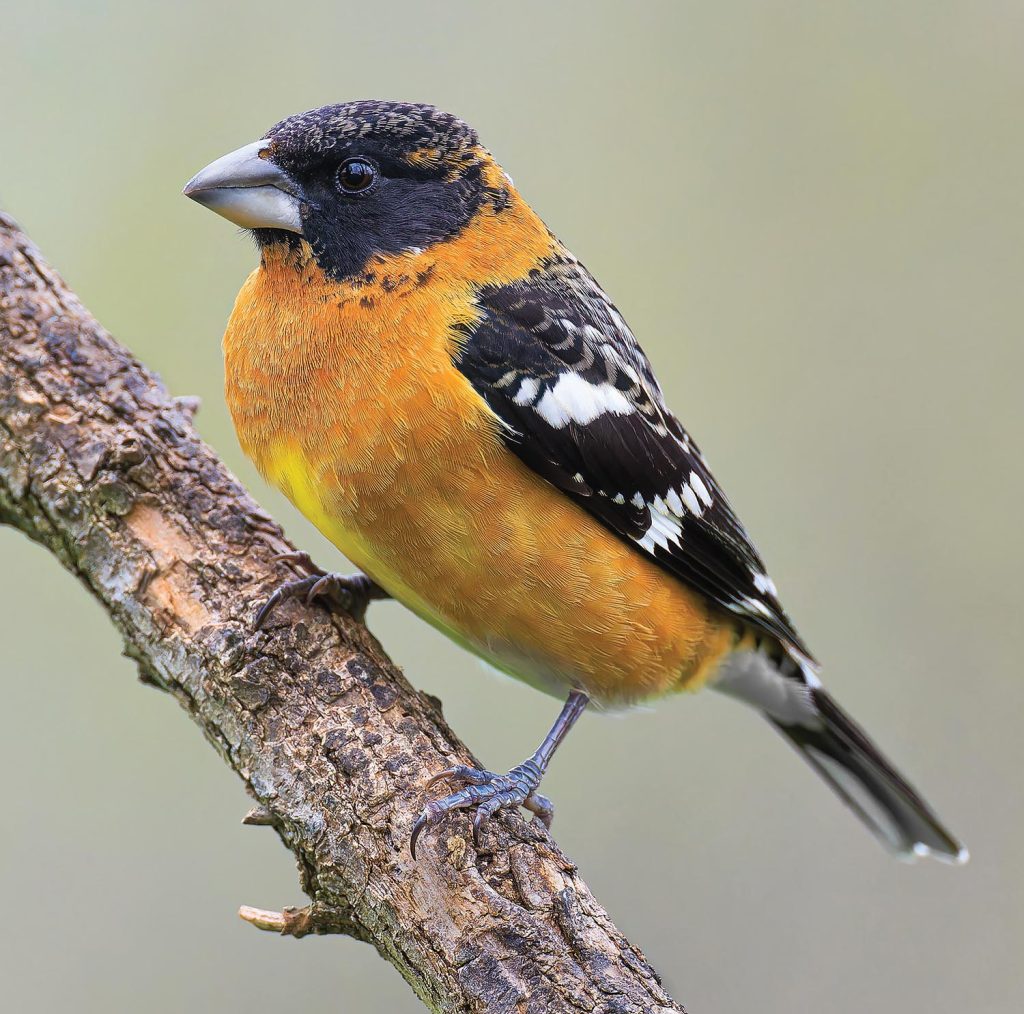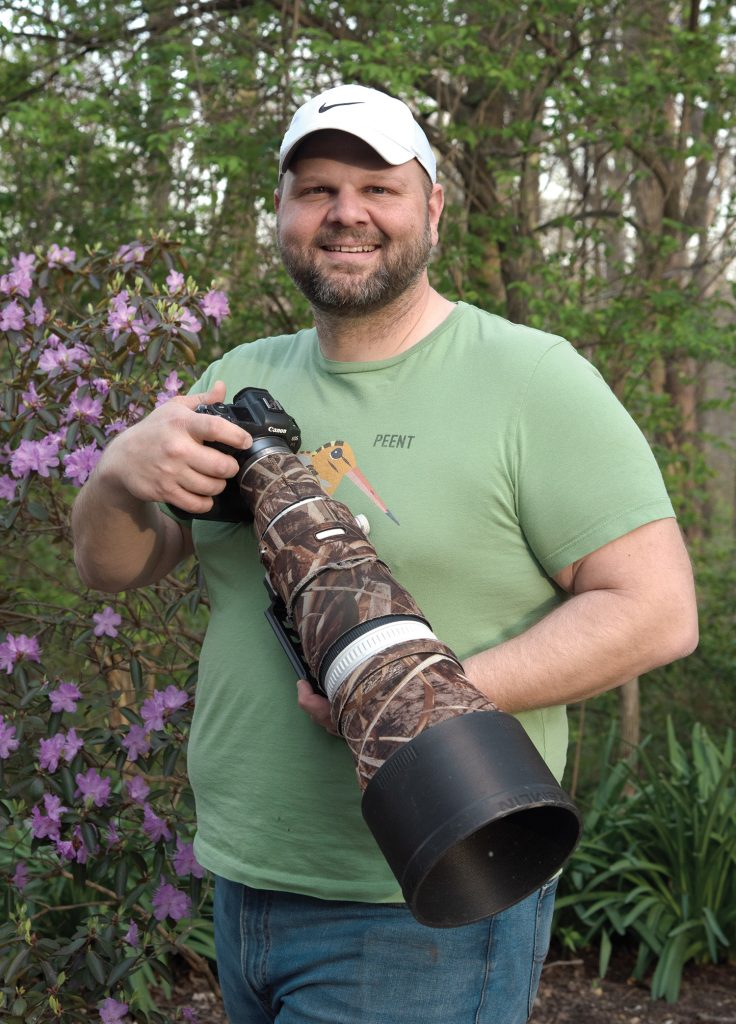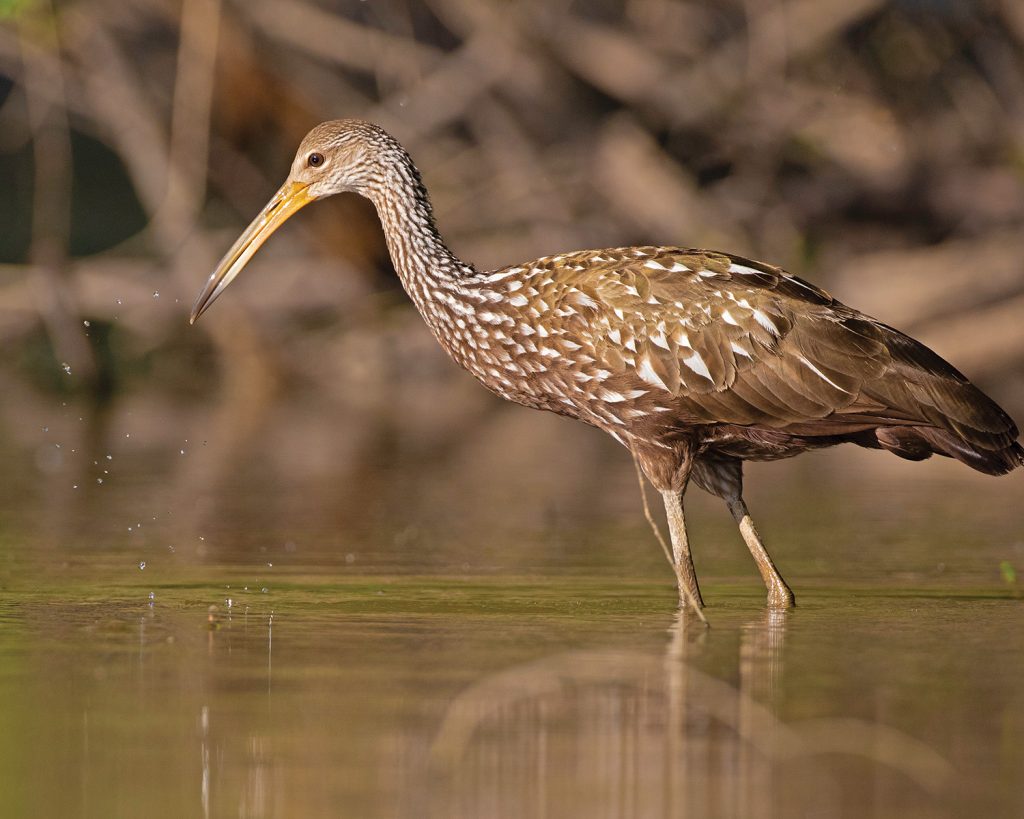
By Richard G. Biever
Janet Cross said she’d never seen anything quite like it.
She may have been talking about the little black and orange bird that showed up at her backyard feeders for a few days in April. She used the bird-identification app Merlin to learn it was a black-headed grosbeak.
But the spectacle for her really was the anxious brood of birders who quickly flocked to her suburban Greenfield neighborhood to catch a glimpse and record images of the strange bird.
“I had no clue it was a rare bird until I posted it out on Facebook, and people started contacting me to come over to see it,” she said. “They sent me a screenshot of a map showing the normal range of the bird, and I’m like, ‘Oooh-oo-kay, come on over.’”
The normal range of the black-headed grosbeak is from the central Plains and Rocky Mountains west to the Pacific Ocean. This was only the second recorded sighting ever of one in Indiana.
“A couple of guys reached out to me almost immediately,” Janet, 60, continued, joined by her husband, Doug, 65. “It just took us a little while to understand the magnitude because it was so unique and so new to us. I was like, ‘What do you mean people are going to come stand in my backyard?’ It was a little nerve-wracking to begin with.”
A flutter of photographers arrived that Saturday afternoon. The couple let it be known that for a few hours the next day, too, their spacious backyard, with its budding and blooming trees backed by a creek, would also be open for those wanting to come and see the vagrant bird. Some 50 avid “birders” — photographers and watchers — came with their binoculars, spotting scopes and yard-long giant camera lenses, on the blustery and wet Sunday afternoon. Some came from the farthest corners of the state, Evansville and Valparaiso, to check out the bird the Crosses had dubbed “Rocky.”
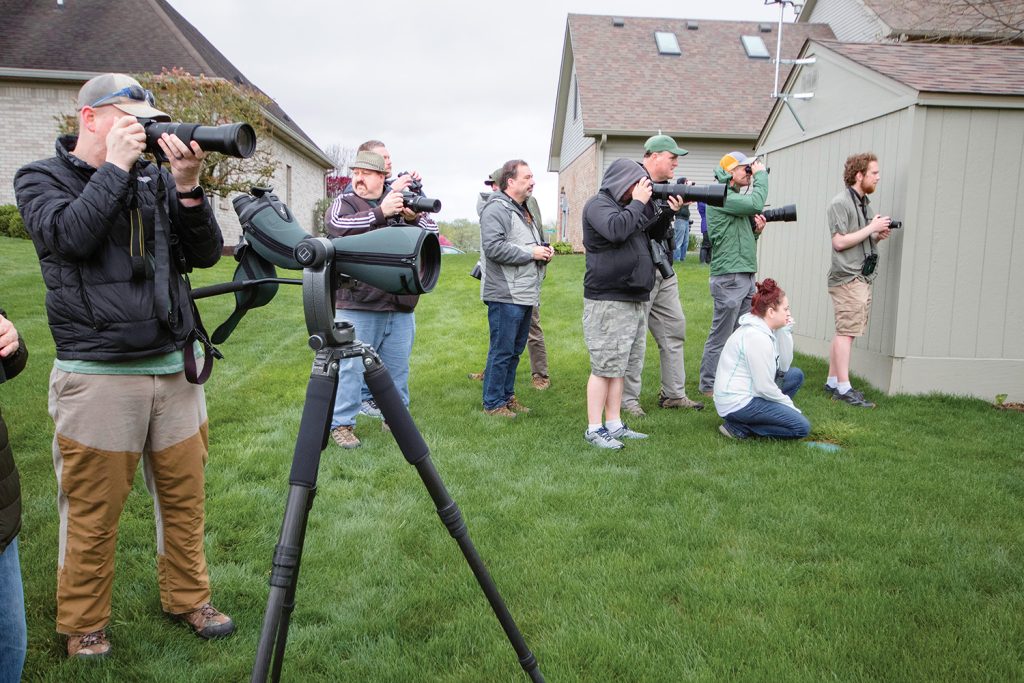
“Everybody we encountered was going out of their way to be polite. I was very impressed,” added Doug. “They are very passionate about what they do. There’s no question
about that.”
A day later, the grosbeak was gone … perhaps heading back to the West.
Birds of a feather
One of the photographers who arrived that Sunday and stayed late, talking birds with the Crosses, was Ryan Sanderson. For Sanderson, the sudden weekend gathering of birders wasn’t out of the ordinary. Capturing photos of rare birds has been an obsession of his for almost 20 years.
Sanderson, 37, is currently chair of the Indiana Bird Records Committee, a committee within the Indiana Audubon Society. Its main goal is to maintain a list of all the bird species seen within the state.
The Indiana Audubon celebrates its 125th anniversary in 2023. It is the oldest conservation organization continuously operating in Indiana and the fourth oldest “Audubon” in the country. Founded in 1898, the organization continues its goals of research, conservation and education of the natural resources and the birds Hoosiers love. Keeping track of bird sightings is part of the research and conservation. Plus, it builds camaraderie and competition among birders to see who can spot the most.
Sanderson said a goal within the birding community is to spur interest in nature by exposing others to the diverse beauty of birds. Marty Jones, 58, concurs. “That’s one reason I take photos,” Jones said. “I want other people to see what I’ve seen and hopefully appreciate birds more and help protect them and their habitats.”
Jones came over from Terre Haute that Sunday afternoon to join Sanderson and the bevy of other birders. He’s active in his local Audubon and land conservancy group.
Bird watching is among the most popular hobbies in the United States, Sanderson noted. But, when it comes to bird lovers, bird photographers like Sanderson and Jones take it to another level. Sanderson said he probably has a million bird photos on his computer hard drives at home. Jones has 5,000 bird photos posted just on SmugMug, an online image hosting and sharing platform.
There are photographers who just want to get a documentation photo of every bird they see and aren’t concerned as much about aesthetics. “Then, there are those,” said Sanderson, “and I’d probably put myself in the realm, who want to get the best picture of every bird species they see. I want to get artistic photos.”
Jones and Sanderson are much the same. When they find the rare bird they are after, they’ll both shoot initial photos just to document that they have it in case it flies away. Then, they’ll keep working for better lighting, a better background or some action the bird will do.
Among birders, there are varying degrees of mania. Some are “listers” whose main goal is to list as many species as they can say they’ve seen in a defined area, whether it’s their yard, county or state. But then, Sanderson pointed out, people can get really into lists — like a “carbon neutral” list of how many birds they see by just walking or cycling. “It can get really intense, but most people that are into it have a life list of everything they’ve ever seen, and then often a state list.”
Birding takes wing
Sanderson, a physician practicing family medicine in northern Johnson County, became interested in birds in the mid-2000s as a college student. He had gotten into art photography in high school and already had a love of nature. But birds didn’t begin entering his picture frames until he took a course on Indiana natural history the spring of his freshman year in 2005. “We went around the state looking at various rock formations and forests,” he noted. “The professor was really into birding. So, we ended up looking at birds through most of the course.”
The next fall, he took a course in ornithology. And then his interest took wing.
At about this time, digital cameras began making a splash on the market. Sanderson sold a saxophone he bought in high school on eBay to help finance his first digital camera — a Canon Rebel. Digital cameras made all the difference since he was no longer confined to 36 images per roll of film and the cost of purchasing and developing film. As digital technology advanced, so did his interest and the number of photos he shot.
Sanderson admits he’s always had kind of an obsessive-compulsive personality, even as a tot. “When I was 4 or 5 years old, I was really into tractors. And then it was frogs for a couple of years. Then I got into snakes.” But birds captivated him. He said he’s asked himself many times, “Why am I so into this? These are just birds. Why is it interesting to me?”
The answer partly seems to be his nature; they appeal to his intellect and analytical mind — which is what also led him to medicine. “Medicine and birding are somewhat similar,” he explained. If a patient comes in with an illness, he pores over their symptoms and complaints to make a diagnosis. If there’s a bird he doesn’t recognize, he can go down a list of physical features, size, colors, patterns and sounds to come up with an identification.
But both his artistic and perfectionist sides have kept him coming back. “I think I can always get a better photo of something. So, it’s always, ‘How can I improve that? How can I do better with this?’”
Plus, advancing digital technology creates a never-ending spiral of improvement. “Maybe I took a fantastic photo eight years ago, but I was using an eight-megapixel camera. So, I really can’t enlarge it. But now I can do cooler stuff. I can blow up the pictures of the head and get some really cool feather details, where before there wasn’t the resolution for that.
“And you just never know what you’re going see,” he continued. “It’s kind of like a new discovery every day when you go out and see warblers. In Indiana, you can see 36-37 warbler species in May. You never know what’s going to show up.”
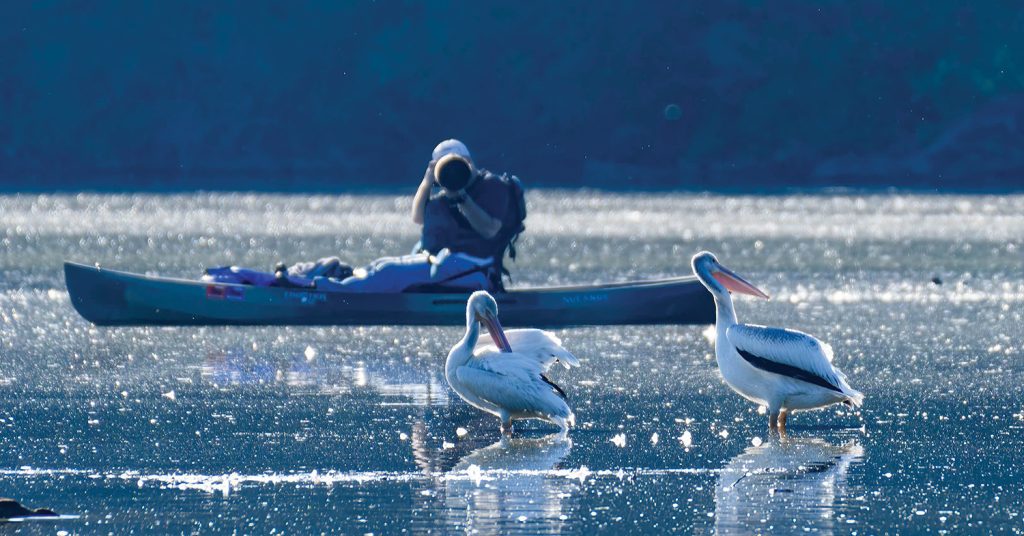
Photo by John Baughman
To make sure he doesn’t miss any rare bird sightings, Sanderson is plugged into a variety of social media and notification methods — Facebook, rare-bird alerts, text messages and the like. These instant notifications of sightings birders share with each other have made it easier to go after the rare birds, but also can create a dilemma for Sanderson that pits his passion against his profession. “I can’t tell you the number of times I’ve gotten an alert, a text message or a Facebook notice that says any number of rare birds have showed up. And so, you’re sitting at work, and it’s like ‘Holy crap, I gotta go see this!’ It’s crazy.”
But that’s when the professional side intervenes. “I’ve made a rule for myself that I will not cancel patients or days at work to go see stuff. I’ve rearranged stuff before, but never have I canceled somebody because I needed to see something. My professional duties to my patients outweigh that.”
Being a tad obsessive, Sanderson is also a bit of a perfectionist — always working hard to be the best at what he does. That includes his bird photography. And while we all carry a little camera with us in our phone these days, Sanderson’s amazing photos don’t simply drop onto his memory card because of the long lenses, kayak and other equipment he has at his command. “I might have been in the field for 12 to 20 hours trying to get that particular picture, so it’s not quite ‘He had a good camera.’ There’s a lot of time and knowledge that’s coming into play to get the consistently good photos of those things. And for the majority of these birds, you can’t just walk up on them because they fly away.”
‘God moments’ with the birds
Marty Jones knows all about the long hours. With the black-headed grosbeak, Jones recorded his 348th species of bird in Indiana.
While the last one came during the open house in the Crosses’ backyard, you don’t get that many without putting in work. His images are on his appropriately named page: IndianaJones.smugmug.com.
Instead of rare treasures of antiquity, this “Indiana Jones” searches for the rare birds of Indiana still around us. But just like the Jones of the movie series, his adventures can be long, treacherous and hard.
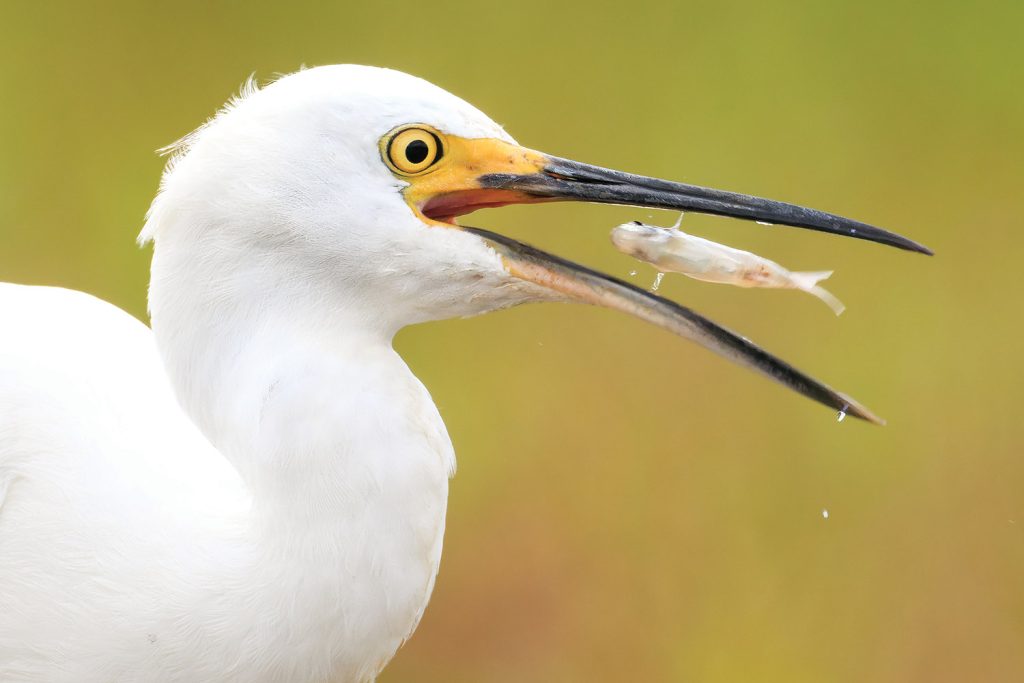
One of his favorite excursions included Sanderson and a few other birders. A ruffed grouse, once common to Indiana but now almost extirpated, was spotted in the Hoosier National Forest. “We took a long hike into the forest,” Jones recalled. “With the camera gear that’s pretty heavy and the rough terrain, it wasn’t easy.”
When they’d gone well over a mile into the middle of the woods, Jones said they started wondering how they would ever find it. Suddenly, one of the others said, “There it is!”
“I’m just trying to get a documentation photo, that’s what I always do when I first see a rare bird,” Jones said. “I get what I can and hope to get a better picture later. And I’m not kidding, that bird was like a chicken. It walked up to us and posed, jumping up on a log.”
The bird got so close, the photographers with their long, fixed lenses attached to their cameras actually had to back up to focus. “We all got awesome photos,” Jones said.
Like Sanderson, Jones, a senior regulatory consultant with Indiana Electric Cooperatives, always had an interest in the outdoors and photography and got into birding in the mid-2000s. And like Sanderson, Jones sold a first love — in his case, a hot rod — to purchase his first long birding lens.
Jones said in the early 2000s, he was spending a lot more time on the road with his job at IEC. “Back then, our department was much smaller. We traveled a lot more all over the state. And so, I would take my camera out on the evenings before going back to the hotel,” he said.
One evening toward dusk in late November or early December, he ended up at the Jasper-Pulaski Wildlife Refuge after spending the day at a nearby REMC.
“That’s when thousands upon thousands, sometimes as many as 30,000 or more, sandhill cranes congregate in this little area in front of a specially constructed observation deck. They’re heading south from Canada, upper Wisconsin, and Minnesota. That was just what I call a ‘God moment,’” he recalled.
“There were probably 100, maybe up to 300, people there, and I was the last to leave,” he added, noting he was shooting photos the whole time.
Not long after, digital cameras came along. And like Sanderson, Jones found them to be a salvation for bird photography. “Digital was just awesome. When you do bird photography, it’s not uncommon to take 1,000 images pretty quickly.”
Through his previous travels with IEC, Jones became a collector of photos. He’d photographed all of Indiana’s courthouses. He’d photographed all the state’s covered bridges. Now, he set his goal to photograph every bird species in the state. “I was thinking this would just be a few months, maybe a year, and I’d move on to something else. Well, here I am … almost 20 years later.”
Unlike Indiana’s courthouses and covered bridges that have a finite number with easy-to-locate coordinates, photographing every bird species was a moving target — in more ways than one. There’s no definite number of species of birds — it can range from 380 or more depending on the season and migrations. Plus, occasionally wildcard vagrants fly in, like the black-headed grosbeak or a limpkin, to upset the aviary cart. And, of course, birds are much harder to photograph than stationary objects.
A limpkin, a tall long-legged marsh bird, was spotted along Monroe Lake in Monroe and Brown counties last June. It created quite a stir — being the first one ever spotted in Indiana. The bird’s normal northernmost territory is the Florida-Georgia line. Jones and Sanderson both were able to get photos of it as photographers descended on the lake.
For Jones, that was a kayak adventure that went from a hot humid mid-afternoon to almost sundown. Just as he was about to call it quits so he could get back to his car before dark, he decided to turn down one more marshy byway. “And I’m glad I did because there it was in perfect light. It’s one of those birds that are spooked easily, but this one, I practically paddled right up to it.”
He said he follows his customary “shoot, shoot, shoot” to get what he can in case it flies off. “Then, after I get my shot, I just try to enjoy the view and appreciate what I’m seeing.”
‘Wrong turn at Albuquerque’
Though the black-headed grosbeak departed without even a fare-thee-well to Doug and Janet Cross, the Greenfield couple wasn’t left empty-handed from their brief encounter with Indiana birding history.
Birders brought bottles of wine, bags of birdseed and a bag of corn and a mineral block for the deer that pass through the yard. Jones provided Janet and Doug a close-up print of their famed visitor. “I’m looking forward to putting it up and having conversations about it when we have guests over,” Janet said. “It was a once-in-a-lifetime memory we’ll
have forever.”
She and Doug doubt Rocky will be back.
“We got our 15 minutes,” Doug said, waxing on the vagaries of the bird’s short sojourn in their backyard. “As he made his way north from Mexico, he took a wrong turn at Albuquerque and got lost. It happens in nature.”
Janet said the experience won’t be turning her and Doug into the birders that go in search of rare birds. “We just enjoy listening to them and watching them out our back door.”
But, they will stay active with the Greenfield birders Facebook group where she first posted her discovery of the grosbeak. “Everybody’s always posting pictures,” Janet said. “When the first hummingbird of the season shows up, we’ll take a picture and post it there, so everybody knows that the hummingbirds are here.” When bluebirds are around, photos get posted so followers know to put out the feed they prefer. “It just keeps everybody aware of what’s going on in the community.”
And the next time a strange bird appears, she said she’ll photograph it and post it, and say, “OK, here’s a new bird for me!” She said the response from fellow birders like Sanderson and Jones might be a ho-hum, “OK, … that’s this type of bird. It’s a common bird.” Or, their reaction just might be, as she paused for a moment and then mused excitedly, “We’ll be back!’”
RICHARD G. BIEVER is senior editor of Indiana Connection.

